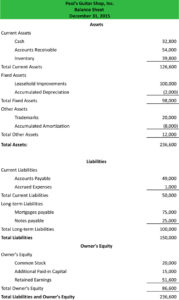In business terms, liability is something that the company owes. Generally, it is an obligation or something that you owe somebody.
Two words, assets and liabilities are heard repeatedly in and around businesses. We published a guide on Business Assets: Definition, Type & More to help you understand such terms. This article will talk about all you need to know about liability.
Table of Contents
What is a liability?
In business terms, liability is something that the company owes. Generally, it is an obligation or something that you owe somebody. Often times, liabilities are also defined as a company’s legal financial debts that arise in the entire course of business operations and growth.
Liabilities are recorded on the right side of the balance sheet <link> which includes components like loans, accounts payable, mortgages etc. In simpler words, liability means credit.
How liabilities work
How does liability reporting in accounting work?
In accounting, liabilities represent an organization’s obligations or debts, which are expected to be settled by transferring assets, providing services, or other activities. Liability reporting involves recording and reporting liabilities in a company’s financial statements in accordance with accounting standards and principles.
The process of liability reporting includes the following steps:
- Identification: First, a company must identify all of its obligations and debts, including both current and long-term liabilities. This may include accounts payable, notes payable, bonds payable, and accrued expenses.
- Measurement: Once the liabilities have been identified, they must be measured and recorded in the company’s accounting system. This involves determining the amount of the liability and the timing of the payment or settlement.
- Recognition: Next, the liabilities must be recognized in the company’s financial statements. This involves recording the liability on the balance sheet and recognizing any related expenses or interest payments in the income statement.
- Disclosure: Finally, the company must disclose information about its liabilities in the notes to the financial statements. This includes information about the nature of the liabilities, the timing of the payments or settlements, and any associated risks or uncertainties.
Overall, liability reporting in accounting is an important process that provides stakeholders with valuable information about a company’s financial health and obligations.
What is a contingent liability?
A contingent liability is a possible obligation or liability that may or may not come to pass, depending on the outcome of future events or circumstances. It’s a liability that could potentially arise from past events or transactions, but whose timing or amount is uncertain. For example, a pending lawsuit against a company is a contingent liability because the outcome of the lawsuit is not certain.
Contingent liabilities are important to disclose in a company’s financial statements because they have the potential to impact the financial position and performance of the company.
What are negative liabilities?
In accounting, a negative liability is a rare occurrence that represents a situation where a company has overpaid for goods or services or has received payments in advance for goods or services that it has not yet provided. A negative liability is also known as a liability credit balance, which is the opposite of a regular liability account that carries a positive balance.
For example, if a customer pays in advance for a product or service that a company has not yet provided, the company would record the payment as a negative liability until the product or service is delivered. Once the company delivers the product or service, it would then recognize the revenue and reduce the negative liability balance.
Assets vs. Liabilities
An asset is something that a business owns or controls and has value, such as cash, inventory, equipment, or property. Assets are used to generate revenue and are usually expected to provide future benefits for the company. For example, a company’s inventory of products can be sold to customers for a profit.
On the other hand, liabilities are what a business owes to others, such as loans, accounts payable, and salaries payable. Liabilities represent the debts and obligations of a business, and they are expected to be paid off in the future. For example, a company may have taken out a loan to purchase equipment, and it must repay that loan over time.
Types of liabilities
Primarily, there are three types of liabilities, current, non-current & contingent liabilities. Let’s dive deeper and understand what each of these means.
- Current liability: Also known as short-term liabilities, current liabilities are debts or obligations that need to be paid within a year. These need to be closely watched by the company to make sure that the company possesses enough liquidity to meet these debts or obligations.
- Non-current liability: Contrary to what current liabilities are, non-current liabilities are debts or obligations that are due in over a year’s time. They are an important part of a company’s long-term financing. Companies take long-term debt to acquire immediate capital to fund the purchase of capital assets or invest in new capital projects. These liabilities are crucial in determining a company’s long-term solvency. If companies are not able to repay their long-term liabilities, and if they become due, the company is likely to face a solvency crisis.
- Contingent liability: These are the business liabilities that may occur, depending on the outcome of future events. These liabilities are also called potential liabilities. Consider this example to understand this better: when a company is facing a lawsuit of $100,000, the company would incur liability if the lawsuit proves successful. In case the lawsuit is not successful, no liability would arise.
In basic accounting standards, a contingent liability is only recorded if the liability is probable (50%+ likely to happen) and the amount of the resulting liability can be reasonably estimated.
Difference between expense & liability
An ‘expense’ is the cost of operations that a company incurs to generate revenue. Unlike assets and liabilities, expenses are directly related to the revenue and both are listed on a company’s income statement. In short, expenses are used to calculate the net income while liabilities are the indication of a company’s credit status.
For example, if a company has more expenses than revenues in its past three years, it may signal weak financial stability because it has been losing money for all those years.
Expenses and liabilities must not be confused with each other. One is listed on a company’s company’s income statement and the other is listed on the company’s balance sheet. Expenses are the costs of a company’s operation, while liabilities are the obligations and debts a company owes.
Examples of liabilities
To understand all of the above-mentioned information, let us take a practical case by having a look at this example:

Liabilities are one of the most vital aspects of a company because they are used to finance the operations and pay for large expansions.
Frequently Asked Questions
How do I know if something is a liability?
You can determine if something is a liability by asking the following questions:
- Does the business owe money or goods and services to someone?
- Has the business received advance payments for goods or services not yet provided?
- Is there an obligation to pay a certain amount in the future?
How are long term liabilities different from current liabilities?
Current liabilities are those that are due within a year while long-term liabilities are those that are due more than one year in the future.
How are assets and equity related to liabilities?
The basic accounting equation tells us that Assets = Liabilities + Equity. This means that a company’s assets are financed by its liabilities and equity.
What sorts of liabilities do individuals or households have?
Individuals and households can have different types of liabilities, such as mortgages, auto loans, credit card balances, student loans, personal loans, and medical debt. Liabilities are financial obligations that must be paid off in the future, and managing them effectively is crucial for financial stability.





